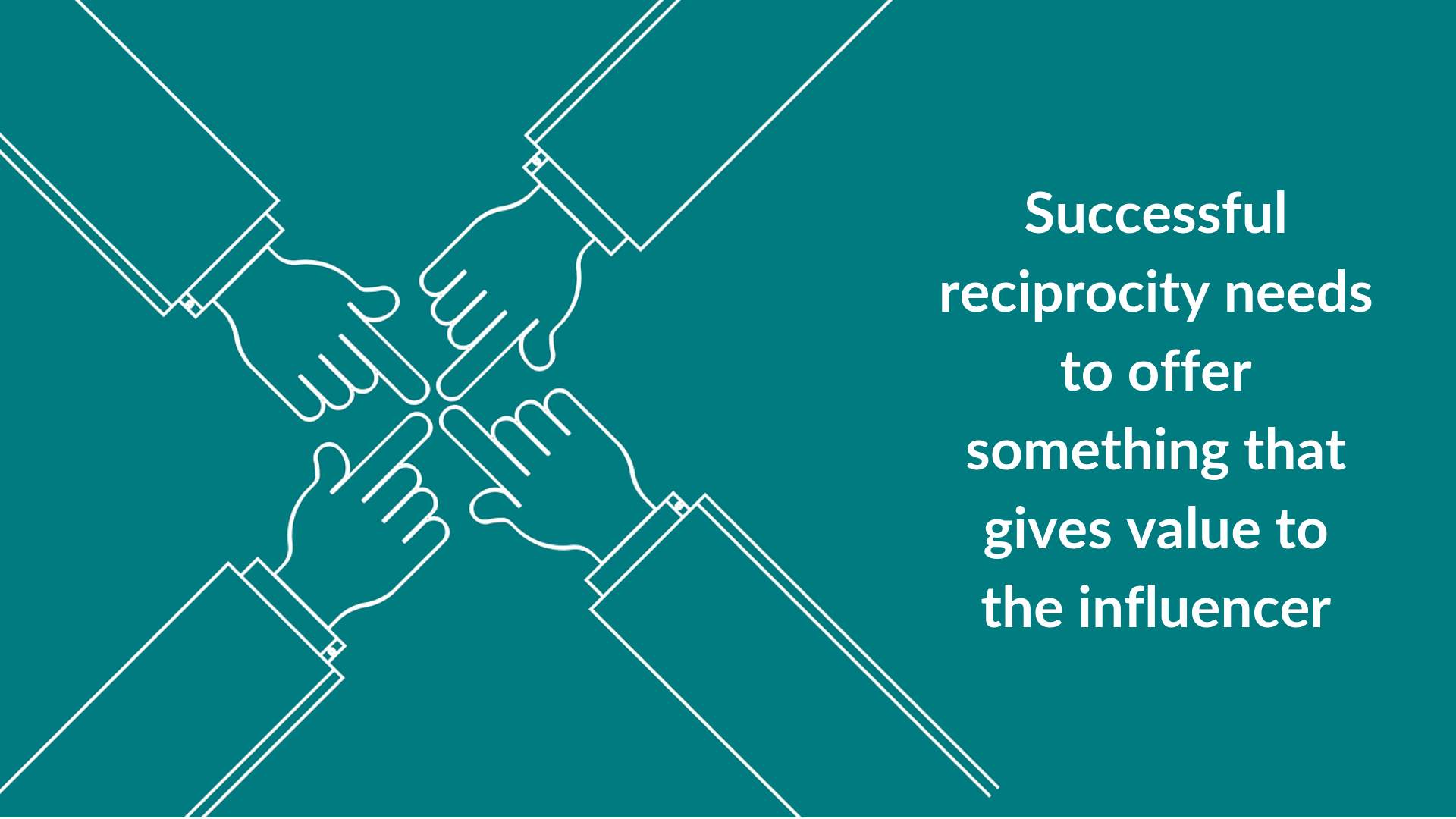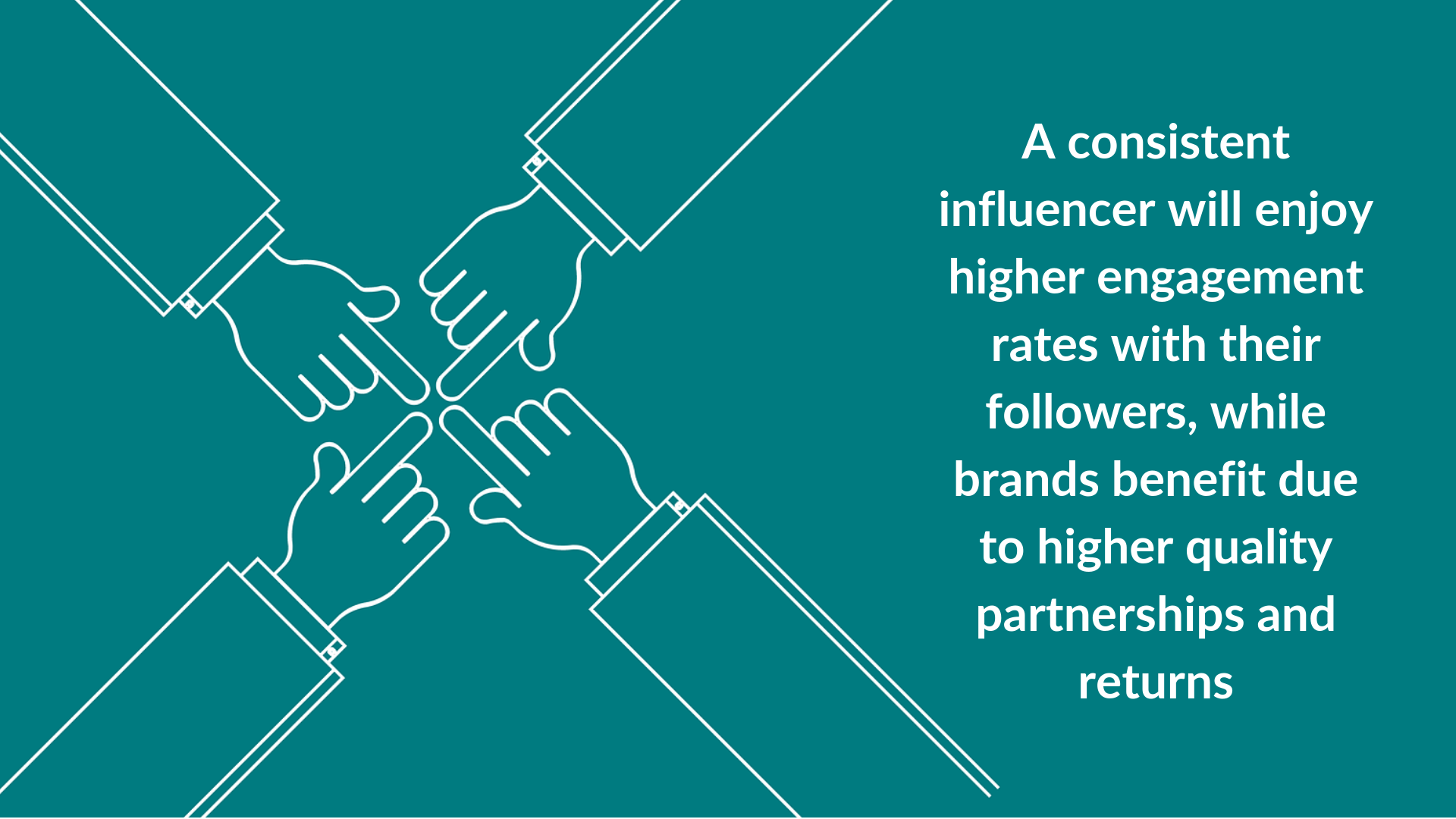The 6 Key Drivers of Influence Marketing to Ensure a Successful Campaign

When it comes to influence marketing, there are several tactics and metrics you can implement/measure to ensure your campaign’s success.
These can range from simple (reach, impressions, blogger outreach, etc.) to more defined and advanced (leads, brand lift, niche communities, etc.).
However, as important as these are, you’ll struggle to implement any of them without a clear idea of what will be driving your influence marketing campaign in the first place.
This includes your own output and interactions as well as that of your influencers.
Below, you’ll find the 6 key influence drivers when it comes to getting the biggest bang for your buck.
The Value of Reciprocity
When working with influencers for your campaigns, the end goal is usually the same – either awareness for your brand or delivering marketing-qualified leads for your sales team.
This is where the value of reciprocity comes into play.
Your business has a goal, and you’re using influencers to help meet that – so you need to give the influencer something to encourage their involvement with you.

There are generally two ways that this happens: paid, monetary incentives, or product reviews/testing/feedback.
Based on goals, a paid influence campaign may be the way to go for your business. However, something to be aware of is the downside of this.
Audiences and consumers are becoming smarter and can see when influencers have been paid to offer their opinions. While these opinions might be valid, the introduction of pay-for-play skews the audience’s perception.
Now, the influencer is seen as a shill and only talking about a product because they’ve been paid to do so.
Compare that to a more organic campaign where the influencer works directly with the brand to improve a product, then improves the customer’s experience with both brand and product, and perception immediately changes.
The influencer is seen as more authentic, and the consumer is more likely to take the action the brand is looking for.
This is why it’s key to get the reciprocity right.
- Make it something that gives value to the influencer (something that improves their life or helps them grow their own brand and/or social channel)
- Make it something that’s relevant to your goal (you wouldn’t ask them to promote a hunting lifestyle if your audience demographic is primarily vegan)
- Make it something that enables the influencer to give something to their own community (from simple coupon codes to lifetime membership of an exclusive loyalty program)
Whatever you decide to offer in exchange for the influencer’s services, it’s key to ensure there’s value in the reciprocity to set each campaign up for success.
The Demand for Scarcity
In 1998, Tiger Electronics released the first version of their Furby toy. An electronic, furry little creature that would respond to you if you petted it, it soon became the must-have toy for kids that year.
Due to overwhelming demand, stores quickly ran out of stock, and parents became frantic as the holiday season approached and Furbies were nowhere to be seen.
As soon as stock was replenished, it sold out, too, and this pattern continued well into 2000.
The Furby launch was a classic case of the demand of scarcity as a marketing tactic – using the fear of shortage to sell more.
As humans, we’re psychologically wired to want something we cannot have, and marketers are more than aware of this. It’s why you see “Limited time only!” offers on display so much, even though the same offer was in place just two weeks prior…
When working with all types of influencers, utilizing the demand of scarcity can drive demand for your product or service.
- A new product launch can only be bought through an influencer’s link (which you can then track to measure leads/sales)
- Access to an invite-only event, with the influencers having a certain amount of invites to give away
- Exclusive discounts or coupons are given to the influencer’s community, but only if a survey is completed by a certain date
Making something feel scarce and exclusive increases interest and demand, as well as buzz around that product or offer.
Get the offer and the timing right, and the positive return for your business could be huge.
The Power of Authority in Influence Marketing
If content is king when it comes to business, then authority takes its place when it comes to influence marketing. Authority of the influencers you work with and the authority they give to your business.
When creating an influence marketing campaign, you’ll have a set of KPIs to work to, whether it’s awareness-driven, lead-driven, sales-driven, or similar.
However, one key metric that shouldn’t be overlooked is that of authority and how your business/brand grows its authority as part of the campaign.
When we talk authority, we’re talking about how your business is perceived:
- Is it a leader in the market or a follower?
- Does it instill the right reaction from its target audience?
- Is it seen in a better light than your competitor?
- Are products and services bought based on reputation?
The more authority your business has, the more likely your target audience is likely to do business with you. This is where trusted influencers come into play.
By working with influencers who not only have the right followers by demographic for your campaign but also have a respected authority within that audience, your business benefits by association.
The real appeal of influencer marketing and the reason for its rapid rise in adoption among brands is its authenticity and the number of ways in which campaigns can be created and utilized to fulfill a variety of projects with varying objectives.
Marketing Week
Influencers – or at least those who place their community over a quick buck – are careful of which businesses they work with. Working with you gives you an immediate increase in trust and authority.
To Grow Results, Consistency is Key
If authority is an important driver of influence marketing, consistency is equally so (though this is true for any part of your marketing or business message).
- Consistency of message, from marketing to customer support
- Consistency of quality, both product and/or service
- Consistency of support when things go wrong
This need for consistency also applies to the influencers you work with. While the three points above are relevant to the influencer, they also need to be consistent in other areas.
- Consistency in ethics (where they aren’t just shilling some brands even though they’ve never used them)
- Consistency in professionalism as a representative of your brand
- Consistency in the quality of any advice/recommendations they’re giving
This all ties back to the Authenticity part of the influencer equation. When looking to work with an influencer, make sure you check how consistent they are in these key areas.

Doing so offers a win-win situation – a consistent influencer will enjoy higher engagement rates with their followers, while brands benefit due to higher quality partnerships and returns.
Going Beyond Liking as a Fluff Metric
When social media was in its heyday, and businesses weren’t bothered about it being used as a marketing tactic, social metrics like Likes and Hearts were seen as validation of a brand’s success.
After all, more Likes equals more people loving your content, right? Not necessarily.
As the networks continued to change their algorithm, and content was seen less – at least organically – the number of Likes also dropped. Did that suddenly mean the content was any less valuable?

While it’s okay to use Likes as a useful metric when it comes to awareness, go beyond these simple clicks and use Likes as the basis for a deeper dive into your audience, especially when it comes to the influencers you’re working with.
- Are the Likes from the right demographic for your business?
- Does certain content (written, video, podcast, rich media) get more Likes than others?
- Are you getting new Likes, or consistently the same people?
To track even deeper, monitor the Likes you’re getting and whether the content with the most Likes is driving traffic to your website via any PURL, you set up for that influencer’s post.
This not only enables you to create more effective content for any influence campaign but also allows you to see which influencer is driving the most value and which one(s) needs more training or letting go.
While Likes are seen as fluff metrics when used as a standalone example of a social post’s success, there are ways they can be used to drive more revenue through targeted and effective messaging – you just need to dig deeper.
It’s All About Social Proof (Well, Mostly)
By now, you should have a good idea of the most effective drivers when it comes to influence marketing.
If you can integrate Reciprocity, Scarcity, Authority, Consistency, and Liking into your campaign and the influencers you work with, you’re definitely on the right path to better results.
However, there’s one metric that can bring all of this together, and that’s social proof. There are a few definitions of social proof, but the two that matter most are:
- Social proof when it comes to your business
- Social proof when it comes to the influencer you’re working with
For your business, social proof can be how many followers you have across various networks, how your brand is perceived, what clients you’ve worked with, and the awards and certifications your business has earned.
For influencers, social proof can also be how many (quality) followers they have, as well as brands they’ve worked with, results they’ve delivered, mentions they’ve encouraged, and advocates they’ve created.

Your influence marketing campaign should be set up to track these metrics and how effective you’ve been at increasing each one.
By working with an influencer (or influencers) that have the right Authority and tracking the campaign throughout so you can make adjustments on the fly, you can increase your social proof by pre-determined timelines.
However, don’t fall into the trap that social proof is all that matters – unfortunately, followers and Likes can be bought, resulting in fake audiences and little return on your investment.
Do your due diligence, vet your influencers, and build a solid marketing plan just like you would for any other campaign or promotion you’d run.
Forge Unbreakable Bonds, Drive Growth
BONDAi is a one-of-a-kind solution combining technology and “the human touch” to build exceptional relationships with clients, prospects, partners, and employees.
Discover the BONDAi Difference Today.